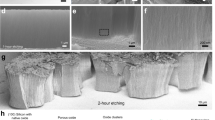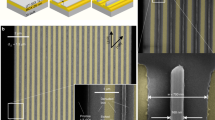Abstract
The assembly of semiconductor nanowires and carbon nanotubes into nanoscale devices and circuits could enable diverse applications in nanoelectronics and photonics1. Individual semiconducting nanowires have already been configured as field-effect transistors2, photodetectors3 and bio/chemical sensors4. More sophisticated light-emitting diodes5 (LEDs) and complementary and diode logic6,7,8 devices have been realized using both n- and p-type semiconducting nanowires or nanotubes. The n- and p-type materials have been incorporated in these latter devices either by crossing p- and n-type nanowires2,5,6,9 or by lithographically defining distinct p- and n-type regions in nanotubes8,10, although both strategies limit device complexity. In the planar semiconductor industry, intricate n- and p-type and more generally compositionally modulated (that is, superlattice) structures are used to enable versatile electronic and photonic functions. Here we demonstrate the synthesis of semiconductor nanowire superlattices from group III–V and group IV materials. (The superlattices are created within the nanowires by repeated modulation of the vapour-phase semiconductor reactants during growth of the wires.) Compositionally modulated superlattices consisting of 2 to 21 layers of GaAs and GaP have been prepared. Furthermore, n-Si/p-Si and n-InP/p-InP modulation doped nanowires have been synthesized. Single-nanowire photoluminescence, electrical transport and electroluminescence measurements show the unique photonic and electronic properties of these nanowire superlattices, and suggest potential applications ranging from nano-barcodes to polarized nanoscale LEDs.
This is a preview of subscription content, access via your institution
Access options
Subscribe to this journal
Receive 51 print issues and online access
$199.00 per year
only $3.90 per issue
Buy this article
- Purchase on Springer Link
- Instant access to full article PDF
Prices may be subject to local taxes which are calculated during checkout




Similar content being viewed by others
References
Lieber, C. M. The incredible shrinking circuit. Sci. Am. 285, 58–64 (2001).
Cui, Y. & Lieber, C. M. Functional nanoscale electronic devices assembled using silicon nanowire building blocks. Science 291, 851–853 (2001).
Wang, J. F., Gudiksen, M. S., Duan, X. F., Cui, Y. & Lieber, C. M. Highly polarized photoluminescence and photodetection from single indium phosphide nanowires. Science 293, 1455–1457 (2001).
Cui, Y., Wei, Q. Q., Park, H. K. & Lieber, C. M. Nanowire nanosensors for highly sensitive and selective detection of biological and chemical species. Science 293, 1289–1292 (2001).
Duan, X. F., Huang, Y., Cui, Y., Wang, J. F. & Lieber, C. M. Indium phosphide nanowires as building blocks for nanoscale electronic and optoelectronic devices. Nature 409, 66–69 (2001).
Huang, Y. et al. Logic gates and computation from assembled nanowire building blocks. Science 294, 1313–1317 (2001).
Bachtold, A., Hadley, P., Nakanishi, T. & Dekker, C. Logic circuits with carbon nanotube transistors. Science 294, 1317–1320 (2001).
Derycke, V., Martel, R., Appenzeller, J. & Avouris, P. Carbon nanotube inter- and intramolecular logic gates. Nano Lett. 1, 453–456 (2001).
Huang, Y., Duan, X. F., Wei, Q. Q. & Lieber, C. M. Directed assembly of one-dimensional nanostructures into functional networks. Science 291, 630–633 (2001).
Zhou, C. W., Kong, J., Yenilmez, E. & Dai, H. J. Modulated chemical doping of individual carbon nanotubes. Science 290, 1552–1555 (2000).
Gudiksen, M. S. & Lieber, C. M. Diameter-selective synthesis of semiconductor nanowires. J. Am. Chem. Soc. 122, 8801–8802 (2000).
Cui, Y., Lauhon, L. J., Gudiksen, M. S., Wang, J. F. & Lieber, C. M. Diameter-controlled synthesis of single-crystal silicon nanowires. Appl. Phys. Lett. 78, 2214–2216 (2001).
Gudiksen, M. S., Wang, J. F. & Lieber, C. M. Synthetic control of the diameter and length of single crystal semiconductor nanowires. J. Phys. Chem. B 105, 4062–4064 (2001).
Wagner, R. S. in Whisker Technology 47–119 (Wiley-Interscience, New York, 1970).
Morales, A. M. & Lieber, C. M. A laser ablation method for the synthesis of crystalline semiconductor nanowires. Science 279, 208–211 (1998).
Duan, X. F. & Lieber, C. M. General synthesis of compound semiconductor nanowires. Adv. Mater. 12, 298–302 (2000).
Cui, Y., Duan, X. F., Hu, J. T. & Lieber, C. M. Doping and electrical transport in silicon nanowires. J. Phys. Chem. B 104, 5213–5216 (2000).
Nicewarner-Pena, S. R. et al. Submicrometer metallic barcodes. Science 294, 137–141 (2001).
Chow, E. et al. Three-dimensional control of light in a two-dimensional photonic crystal slab. Nature 407, 983–986 (2000).
Huang, M. H. et al. Room-temperature ultraviolet nanowire nanolasers. Science 292, 1897–1899 (2001).
Bachtold, A. et al. Scanned probe microscopy of electronic transport in carbon nanotubes. Phys. Rev. Lett. 84, 6082–6085 (2000).
Hu, J., Ouyang, M., Yang, P. & Lieber, C. M. Controlled growth and electrical properties of heterojunctions of carbon nanotubes and silicon nanowires. Nature 399, 48–51 (1999).
Bennett, C. H. & DiVincenzo, D. P. Quantum information and computation. Nature 404, 247–255 (2000).
Acknowledgements
We thank X. Duan for discussions, and W. MoberlyChan and A. J. Garratt-Reed for assistance with TEM imaging and analysis. M.S.G. thanks the NSF for predoctoral fellowship support. C.M.L. acknowledges support of this work by the Office of Naval Research and Defense Advanced Projects Research Agency.
Author information
Authors and Affiliations
Corresponding author
Ethics declarations
Competing interests
The authors declare no competing financial interests.
Rights and permissions
About this article
Cite this article
Gudiksen, M., Lauhon, L., Wang, J. et al. Growth of nanowire superlattice structures for nanoscale photonics and electronics. Nature 415, 617–620 (2002). https://doi.org/10.1038/415617a
Received:
Accepted:
Issue Date:
DOI: https://doi.org/10.1038/415617a
This article is cited by
-
Investigation on electrical, structural, magnetic, optical properties and EPR studies of CdCu2O3 composite oxide prepared via sol–gel method
Indian Journal of Physics (2024)
-
Tunneling between parallel one-dimensional Wigner crystals
Scientific Reports (2022)
-
Nanoparticle-on-mirror cavity: a historical view across nanophotonics and nanochemistry
Journal of the Korean Physical Society (2022)
-
Role of defects and oxygen vacancy on structural, optical and electronic structure properties in Sm-substituted ZnO nanomaterials
Journal of Materials Science: Materials in Electronics (2022)
-
Synthesis, properties and uses of ZnO nanorods: a mini review
International Nano Letters (2022)
Comments
By submitting a comment you agree to abide by our Terms and Community Guidelines. If you find something abusive or that does not comply with our terms or guidelines please flag it as inappropriate.



